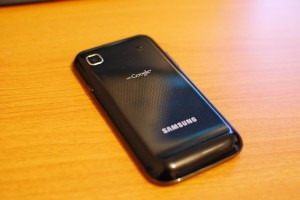On Monday I recieved my shiny new Samsung Galaxy S mobile phone. I’ve been putting off getting a smart phone for quite some years now as I never felt there was anything worth spending money on, and after some experience with my ipod touch I was put off getting an iphone. Anyway, I felt like writing my thoughts on the device now I’ve had it a week.
The hardware
 My first impressions were that it does indeed look a lot like the iphone 3g, and I found I was trying to press the standby button which wasn’t there quite often, as well as picking it up and holding it upside down. As other reviews have pointed out, the handset does feel very light – this was a bit strange at first as I’m used to my wife’s iphone 3gs which weighs considerably more.
My first impressions were that it does indeed look a lot like the iphone 3g, and I found I was trying to press the standby button which wasn’t there quite often, as well as picking it up and holding it upside down. As other reviews have pointed out, the handset does feel very light – this was a bit strange at first as I’m used to my wife’s iphone 3gs which weighs considerably more.
When I turned it on, I was genuinely impressed by how bright and sharp the display was – it easily outdoes the iphone 3g/3gs screen (I think the iphone 4 screen is probably better though.)
One thing a lot of reviews will skip over is how well the phone makes phone calls – I had no problems making a call from the phone, however because the phone’s speaker is on the back it’s sometimes hard to hear it ring if it’s on a flat surface.. bit of a weird issue but an issue non the less.
The sensitivity of the touch screen was reassuring. One reason why I’ve put off getting an android phone until now is because I’ve seen videos on the internet of slower devices and been really put off by the lag you can see when scrolling/pinching to zoom etc.. fortunately this isn’t a problem here. I did notice however that the accuracy of where you place your finger to begin with and then start to scroll is slightly off.. not a problem but I don’t think that happens on the iphone.
Inside, there is a SIM card slot (obviously) and an empty micro sd slot for adding more memory. My SGS came with 16MB of internal memory, which is strangely referred to as an SD card from within Android – my guess is that it does indeed use an internal sd card somewhere as it was probably a cheap way of manufacturing the thing.
Speaking of cheapness, the phone does feel a tad cheap compared to the iphone, although compared to any other device I’d say it’s fairly well built (certainly a lot better than my dell laptop for example!)
The GPS sensor on the phone seemed fairly good although it wasn’t so great when I went under some trees and when I began a walk to my local town to test it. There are known issues with the GPS which will be fixed next month (September) with a software update.
The compass and tilt sensors seem fairly standard. The compass only seems to be accurate if the phone is being held up rather than laid flat, but I guess that’s normal.
The front facing camera was fairly crappy, but I haven’t really found a use for it yet.. hopefully Skype will be released properly for Android soon so I can make use of it.
The software
 Unfortunately, Samsung have decided to install their own custom software on the phone which is not easily removed (as far as I know you have to root the device.) This is apparent straight away as there’s a fairly naff locked screen thing and there’s a samsung task killer widget on one of your home screens. One of the nice things about android is you can customise it quite a bit so removing that widget and all the crappy samsung items from your home screens is easy enough.
Unfortunately, Samsung have decided to install their own custom software on the phone which is not easily removed (as far as I know you have to root the device.) This is apparent straight away as there’s a fairly naff locked screen thing and there’s a samsung task killer widget on one of your home screens. One of the nice things about android is you can customise it quite a bit so removing that widget and all the crappy samsung items from your home screens is easy enough.
I got this phone with version 2.1 of the Android OS also called Eclair, which is a fairly modern release although the most recent is 2.2 – Froyo which is due to be released for the SGS next month. One of the first things that struck me about the OS was how different it felt from the iphone operating systems (including iOS4.) Even though the home screen that the SGS uses is blatantly set up to mimic the iPhone’s, it’s still very different and there was certainly a bit of a learning curve to using it.
The first thing you notice is how there are more menus and options than on the iphone, which at first was a little bit strange, but now seems pretty logical. Rather than apps having a back button, there’s a physical button on the phone (a touch sensitive one,) along with a menu button which brings up a context menu much like right clicking something in windows. Having a back button is great, it’s certainly something I think Android has over the iPhone.
 Another big feature of Android is the fact it does real multi tasking unlike the iPhone. This feature is certainly cool and useful, but requires some thought on the users part. I think this is the real deal breaker for whether someone will prefer Android to the iphone or not as some (bad) programs like to use up lots of CPU time when they’re in the background and this can slow things down and make stuff laggy. At first I was killing apps off left right and centre, but after doing a bit of a search on google I found that perhaps this isn’t the best idea.. and I think they’re right.. it’s basically working the same as your computer does by keeping apps resident in the memory it means if you ‘load’ them again or switch back this will be instant rather than having to load the app back of the internal storage. It’s quite complicated to explain, and for this reason alone I think anyone used to the iphone’s way of doing things will get pissed off with this until they ‘get it.’
Another big feature of Android is the fact it does real multi tasking unlike the iPhone. This feature is certainly cool and useful, but requires some thought on the users part. I think this is the real deal breaker for whether someone will prefer Android to the iphone or not as some (bad) programs like to use up lots of CPU time when they’re in the background and this can slow things down and make stuff laggy. At first I was killing apps off left right and centre, but after doing a bit of a search on google I found that perhaps this isn’t the best idea.. and I think they’re right.. it’s basically working the same as your computer does by keeping apps resident in the memory it means if you ‘load’ them again or switch back this will be instant rather than having to load the app back of the internal storage. It’s quite complicated to explain, and for this reason alone I think anyone used to the iphone’s way of doing things will get pissed off with this until they ‘get it.’
Anyway, the apps from google seem very good, perhaps with the exception of google listen which seems to have a very laggy interface – which is surprising. I won’t go into any individual apps as there’s a lot of good/fun ones I’ve been playing around with and I don’t want to spend too long writing this.
All in all I’m very happy with the handset, I get fairly decent battery life out of fairly heavy (but careful) usage – perhaps just under 2 days. I’ll probably make some additions and corrections to this post over the weekend.



